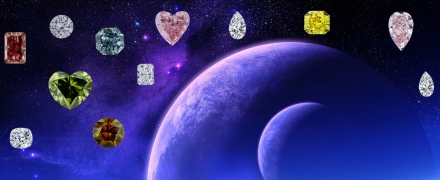open 10 am - 7 pm
laboratory is closed
Space Cut Diamonds

Among the wide variety of diamond cuts, there are even those related to space. Let's talk about some of the most common types of such cuts. This is how the semi-circular brilliant cut, developed in the period 1920-30, was named "Half Moon". Its appearance is explained by the popularity of the idea of space flights, as a rule, associated at that time with flights to the moon. Another cut, named Jupiter in honor of the ancient god Jupiter and the planet of the same name, was developed in the early 2000s by the Indian firm Gitanjali in collaboration with the Belgian cutter Adri Voorn. The cut has the shape of a "pentagon" with pavilion faces arranged in the form of a five-pointed star. The presentation of this cut took place in 2004. The diamond cut with the romantic name "Rising Star" was developed in the very early 1990s and was patented in the USA in 1992. The cut is a five-pointed star and has 56 crown and pavilion facets. The Spirit Sun cut, reminiscent of the sun in pagan religions, was developed in the early 1990s by the German cutter Ulrich Freiesleben. The cut has a round shape, 32 facets (16 on the crown and on the pavilion) and has no platform. Also among the descriptions of the many varieties of brilliant cut, you can find references to less common cuts, such as "Sputnik" and "Rocket", resembling these spacecraft in appearance.
В геммологической практике бывают весьма увлекательные случаи с диагностикой ювелирных вставок
Но помимо редкости цвета и высокой стоимости таких камней, многие розовые камни выделяются одной замечательной особенностью – они проявляют плеохроизм, то есть в зависимости от положения осмотра камня он может иметь дополнительные оттенки – оранжевый или пурпурный.
Currently, gemstones are produced by two fundamentally different technological methods - the High Pressure - High Temperature method (“HPHT”, High-pressure & High-temperature) and the Chemical Vapor Deposition (“CVD”, Chemical vapor deposition) method. The "HPHT" method is the most tested classical synthesis method, which can be used both carbon deposition on diamond from flux melts and catalytic reactions. In "CVD" synthesis, diamond growth occurs on a seed during carbon deposition mainly from a gaseous medium at relatively low temperatures and pressures.
Jewelry and precious stones are just such a category of goods, when buying which you need to pay attention to many criteria.
Sogdianite is a rather rare mineral and more often it can be found as a collection material (moreover, in systematic collections), and it is extremely rare in jewelry.






